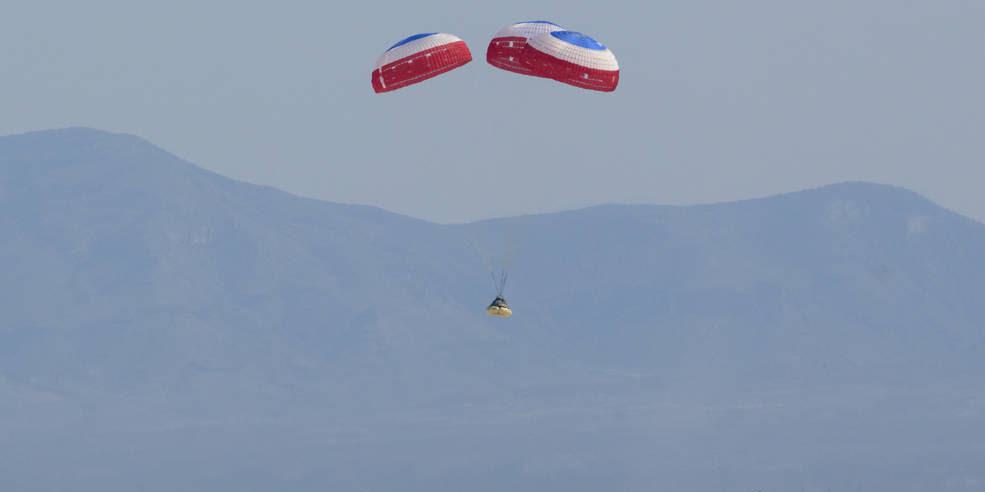NASA and Boeing safely landed the CST-100 Starliner spacecraft on Wednesday in a desert in the western United States. The desert recovery of Boeing’s Starliner completed the spacecraft’s uncrewed Orbital Flight Test-2 (OFT-2) to the International Space Station. The mission helped prove that the system is ready to fly astronauts into space.
“NASA’s Commercial Crew Program and our industry partner, Boeing, today took a major and successful step on the journey to enabling more human spaceflight missions to the International Space Station on American spacecraft from American soil,” said NASA Administrator Bill Nelson. “The OFT-2 mission represents the power of collaboration, which allows us to innovate for the benefit of humanity and inspire the world through discovery. This golden era of spaceflight wouldn’t be possible without the thousands of individuals who persevered and poured their passion into this great achievement.”
Mark Nappi is the vice president and program manager of the Boeing Commercial Crew Program.
“We have had an excellent flight test of a complex system that we expected to learn from along the way and we have,” said Nappi. “Thank you to the NASA and Boeing teammates who have put so much of themselves into Starliner.”
Much of the work on the Starliner was performed at United Launch Alliance’s (ULA) facility in Decatur. ULA is jointly owned by Boeing and Lockheed Martin.
As part of the flight test for NASA’s Commercial Crew Program, Boeing accomplished planned test objectives, including:
· Starliner launch and normal trajectory to orbital insertion
· Launch of United Launch Alliance’s (ULA) Atlas V and dual-engine Centaur second stage
· Ascent abort emergency detection system validation
· Starliner separation from the Atlas V rocket
· Approach, rendezvous, and docking with International Space Station
· Starliner hatch opening and closing, astronaut ingress, and quiescent mode
· Crew habitability and internal interface evaluation
· Starliner undocking and departure from the space station
· Starliner deorbit, and crew module separation from the service module
· Starliner descent and atmospheric entry with the aero-deceleration system
· Precision targeted landing and recovery
The Atlas V rocket that launched Starliner into space was built in Alabama by ULA.
Steve Stich is the manager of NASA’s Commercial Crew Program.
“I am incredibly proud of the dedication and perseverance shown by the NASA, Boeing and ULA team culminating in the successful completion of Starliner’s second Orbital Flight Test from start to finish,” said Stich. “Throughout this process, Starliner has provided a tremendous amount of valuable data, which we’re continuing to assess in our effort to bring the spacecraft online and fully operational for crew flights to the space station as soon as it is safe to do so.”
Boeing said that when Starliner completes its next flight, Boeing will have fulfilled NASA’s goal of having two commercial vehicles to transport astronauts safely, reliably and sustainably to the station from American soil.
“With the completion of OFT-2, we will incorporate lessons learned and continue working to prepare for the crewed flight test and NASA certification,” Nappi added.
The flight test began last Thursday when Starliner launched on the ULA Atlas V rocket from Space Launch Complex-41 at Cape Canaveral Space Force Station in Florida.
Starliner successfully entered Earth’s orbit, performed a series of demonstrations of its capabilities, and docked with the International Space Station just 26 hours after launch. The Expedition 67 crew aboard the station opened hatches and entered the capsule for the first time, inspecting the spacecraft and verifying integration with power and communications station systems for longer stays in the future. The station crew also unloaded 500 pounds of cargo delivered to the ISS by Starliner. The ISS crew then loaded 600 pounds of cargo in the Starliner for it to carry back to Earth.
Joel Montalbano is the manager of NASA’s International Space Station Program.
“Congratulations to the NASA and Boeing teams,” said Montalbano. “I am excited to see the completion of a critical step in bringing another system online to transport long-duration crew members to and from the International Space Station. Soon, we hope to see crews arrive to the space station on Starliner to continue the important microgravity scientific research and discovery made possible by the orbiting laboratory.”
Starliner also carried a “passenger” on this flight test – a lifelike test device named Rosie.
Boeing retrieved the spacecraft from the desert and will transport it back to the company’s Commercial Crew and Cargo Processing Facility at NASA’s Kennedy Space Center in Florida for processing.
Numerous Alabamians have performed work on or engineering for Starliner, the Atlas V, and the International Space Station over the years.
To connect with the author of this story, or to comment, email brandon.moseley@1819News.com.
Don’t miss out! Subscribe to our newsletter and get our top stories every weekday morning.










